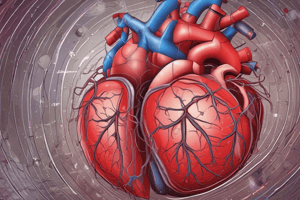Podcast
Questions and Answers
What is the primary goal for blood pressure reduction in a hypertensive emergency within the first hour?
What is the primary goal for blood pressure reduction in a hypertensive emergency within the first hour?
- Reduce systolic blood pressure to below 140 mmHg
- Eliminate all symptoms of hypertension
- Reduce mean blood pressure by 10%
- Reduce mean blood pressure by 25% (correct)
How should blood pressure be managed beyond the first hour during a hypertensive emergency?
How should blood pressure be managed beyond the first hour during a hypertensive emergency?
- It should be elevated to prevent possible organ damage.
- It should be normalized immediately to avoid complications.
- It should be gradually lowered over 24-48 hours if tolerated. (correct)
- It should remain unchanged until symptoms worsen.
Which of the following statements about treatment options for hypertensive emergencies is true?
Which of the following statements about treatment options for hypertensive emergencies is true?
- Treatment is usually done with oral medications only.
- Immediate intravenous medications are not necessary.
- Treatment depends on the presence of specific organ damage. (correct)
- All patients receive the same treatment protocol.
What is a critical consideration when reducing blood pressure in a hypertensive emergency?
What is a critical consideration when reducing blood pressure in a hypertensive emergency?
What is a key goal of using IV medications in the treatment of hypertensive emergencies?
What is a key goal of using IV medications in the treatment of hypertensive emergencies?
In a case of hypertensive emergency, what is the maximum recommended percentage reduction of mean blood pressure within the first hour?
In a case of hypertensive emergency, what is the maximum recommended percentage reduction of mean blood pressure within the first hour?
What is the rationale behind gradual lowering of blood pressure in hypertensive emergencies?
What is the rationale behind gradual lowering of blood pressure in hypertensive emergencies?
Which characteristic is essential for drug selection in treating hypertensive emergencies?
Which characteristic is essential for drug selection in treating hypertensive emergencies?
After the initial hour of treatment for hypertensive emergency, how long should further blood pressure reduction to normal levels be continued if tolerated?
After the initial hour of treatment for hypertensive emergency, how long should further blood pressure reduction to normal levels be continued if tolerated?
Which method is primarily used for the rapid control of blood pressure in a hypertensive emergency?
Which method is primarily used for the rapid control of blood pressure in a hypertensive emergency?
Study Notes
Treatment of Hypertensive Emergency
- Rapid control of blood pressure is essential using intravenous (IV) medications.
- Goal is to reduce mean arterial pressure by approximately 25% within the first hour.
- Further reduction to normal blood pressure levels should occur over a span of 24 to 48 hours, depending on patient tolerance.
- Gradual lowering of blood pressure is crucial to prevent potential complications.
Drugs for Hypertensive Emergencies
- Treatment is personalized based on the specific organ damage present in the patient.
- Selection of medications is informed by the severity and type of organ injury.
- The approach must ensure that blood pressure isn't lowered too quickly, maintaining patient safety.
Treatment of Hypertensive Emergency
- Rapid but controlled reduction of blood pressure is crucial in a hypertensive emergency.
- Intravenous (IV) medications are preferred for immediate effect.
- The target is to decrease mean arterial pressure by 25% within the first hour of treatment.
- Further blood pressure reduction to normal levels should occur over 24 to 48 hours if the patient tolerates the treatment.
- Gradual lowering of blood pressure helps prevent complications associated with too rapid a decrease.
Drugs for Hypertensive Emergencies
- Selection of antihypertensive drugs is tailored specifically to the patient’s organ damage and clinical scenario.
- Individualized treatment plans are essential to address the unique circumstances of each case.
- Monitoring and adjusting therapy based on patient response is critical for safe management.
Studying That Suits You
Use AI to generate personalized quizzes and flashcards to suit your learning preferences.
Description
This quiz covers essential protocols for the rapid control of blood pressure in hypertensive emergencies through intravenous medications. It emphasizes the importance of a carefully controlled reduction in mean arterial pressure to ensure patient safety and the personalization of treatment based on specific organ damage.




